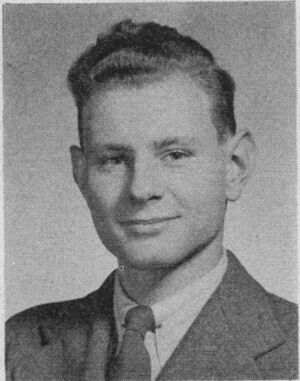Ernest Kretzmer
- Birthdate
- 1924/12/24
- Birthplace
- Mönchengladbach, Germany
- Death date
- 2024/08/24
- Fields of study
- Electrical engineering
Biography
Ernest Kretzmer graduated from Worcester Polytechnic Institute (WPI) in 1944 and received his M.S. and doctorate from MIT in 1946 and 1949 respectively. He served as an instructor and researcher at MIT's new Research Laboratory for Electronics (RLE) and Joint Services Electronics Program (JSEP). His doctoral thesis was republished as an RLE report on "Interference Characteristics of Pulse-time Modulation."[1] Kretzmer published another report on "Distortion in Pulse-duration Modulation" that was reprinted in Proceedings of the I.R.E.[2] in 1947, with ten of its fourteen citations appearing since 1993.
The significance of Kretzmer's research on pulse-modulation phenomena[3] during his post-World War II studies at MIT was recognized in JSEP's 40th anniversary history; his 1966 paper, "Generalization of a Technique for Binary Data Communication," has been cited 310 times.
Kretzmer then joined Bell Labs where for two years he joined the effort to apply the recently invented transistor to military needs. Between 1951 and 1962 he focused on digital communications and circuits in AT&T's Television Research Group. There he published a landmark article on applying information theory to broadcast television signals, "Statistics of Television Signals"[4] as part of an effort to explore ways in which AT&T could reduce the bandwidth of NBC and CBS television programs transmitted over its microwave and landline networks. Together with colleagues he emphasized the utility of Norbert Wiener's theory of linear prediction in feedback communications systems, and advocated using it to reduce the redundancy, and therefore the power needed, in highly periodic signals, like television's. Kretzmer's article has been cited over 350 times, and he pioneered digital compression techniques for television (U.S. Patent 2850574,[5] U.S. Patent 2906816,[6] U.S. Patent 2946851[7]) that were cited frequently over the next 40 years.
Kretzmer's approach became additionally useful when AT&T innovated its Picturephone in the 1960s, and he directed one of the Bell Labs groups that contributed to the research and development of the corporation's Transaction Network Service, a form of digital text messaging and electronic payments, in the following decade.
By the time that Kretzmer retired in 1983, he had been awarded 26 U.S. patents. He was a member of Sigma Xi and had served as an officer of the IRE's Information Theory and Modulation Systems Committee and on the IRE Professional Group on Information Theory's Administration Committee.
After retiring to Sarasota, Florida, Dr. Kretzmer and his wife Alisa became major supporters of the arts, particularly music, and Jewish causes.
References
- ↑ https://dspace.mit.edu/handle/1721.1/5035
- ↑ https://ieeexplore.ieee.org/document/9764896
- ↑ https://dspace.mit.edu/discover?rpp=10&etal=0&query=Kretzmer&group_by=none&page=1&filtertype_0=author&filter_relational_operator_0=authority&filter_0=39d8d1311ed0908bb396e9b82c28d62e
- ↑ https://vtda.org/pubs/BSTJ/vol31-1952/articles/bstj31-4-751.pdf
- ↑ https://patents.google.com/patent/US2850574A
- ↑ https://patents.google.com/patent/US2850574A
- ↑ https://patents.google.com/patent/US2946851A/
